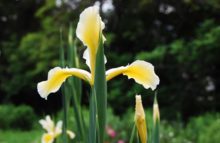This year, the Perennial Plant Association has chosen the beautiful Hakonechloa macra ‘Aureola’, golden Japanese fountain grass, as its Perennial Plant of the Year 2009. If you visit their site, you can download a plant sheet with the lowdown.
Plants of the Year (PotYs?) have been selected through votes by PPA members, judged on criteria that make these varieties good choices for most gardens.
They’re generally:
- Suited to a wide range of climatic conditions
- Low maintenance
- Resistant to pests and diseases
- Readily available
- Offer ornamental interest in multiple seasons
- Easily propagated
PotYs are usually worth knowing. Past stars grown to good effect by Sarah & I in our Toronto gardens include 2008’s Geranium ‘Rozanne’ – everyone should own at least one of these long-term beautiful bloomers – and 1999’s Rudbeckia fulgida ‘Goldsturm’, a sturdy and reliable black-eyed Susan, even in Sarah’s dry, sandy, mostly shade garden. [Update: It is shorter-lived under those conditions, though. “Perennial” does not mean a plant lives forever.]
Now we come back to 2009, and the point of my article, which is:
Choose the plant to suit your garden. If your garden is small, don’t plant a large tree and then amputate it when it outgrows its space. If your garden is in a cool zone, don’t expect a warm-zone plant to thrive.
Now, I absolutely love Hakonechloa grass. I have planted it, twice, each time with visions in my head: the variegated leaves cascading in a golden wave over the stonework in perfect, and as the name says, fountainlike contrast to my misty blue-leafed Hosta ‘Halcyon’.
And I have killed it. Twice.
That’s because my soil is sandy, waaaaaaaaaaaaay sandy. In spring, when the visions (see above) are taking shape, I can fool myself into thinking my soil is, as H. macra requires: moist, humus-rich, well-drained soil. It is certainly well drained. That’s the problem. I do my best to augment it with compost to make it humus rich. However, come July, despite my best mulching efforts, it is dry as dust. Like a good “green” girl, I let the garden water itself. That has been the double undoing of one of my all-time fave foliage plants.
So, by all means, go for the gusto when choosing plants for your garden. I wish you every success with this marvelous specimen. Just remember: you can’t fool mother nature.
[Update: In fact, Hakonechloa or Hakone grass is often recommended for dry shade, and we’ve seen it do well – once established. You do need to pay extra attention to watering during dry spells in the first couple of years, or certainly the first year, after planting. Be informed, and be patient.]




